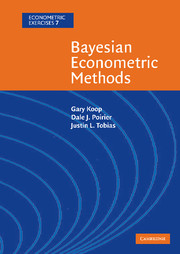Book contents
- Frontmatter
- Contents
- List of exercises
- Preface to the series
- Preface
- 1 The subjective interpretation of probability
- 2 Bayesian inference
- 3 Point estimation
- 4 Frequentist properties of Bayesian estimators
- 5 Interval estimation
- 6 Hypothesis testing
- 7 Prediction
- 8 Choice of prior
- 9 Asymptotic Bayes
- 10 The linear regression model
- 11 Basics of Bayesian computation
- 12 Hierarchical models
- 13 The linear regression model with general covariance matrix
- 14 Latent variable models
- 15 Mixture models
- 16 Bayesian model averaging and selection
- 17 Some stationary time series models
- 18 Some nonstationary time series models
- Appendix
- Bibliography
- Index
18 - Some nonstationary time series models
Published online by Cambridge University Press: 05 June 2012
- Frontmatter
- Contents
- List of exercises
- Preface to the series
- Preface
- 1 The subjective interpretation of probability
- 2 Bayesian inference
- 3 Point estimation
- 4 Frequentist properties of Bayesian estimators
- 5 Interval estimation
- 6 Hypothesis testing
- 7 Prediction
- 8 Choice of prior
- 9 Asymptotic Bayes
- 10 The linear regression model
- 11 Basics of Bayesian computation
- 12 Hierarchical models
- 13 The linear regression model with general covariance matrix
- 14 Latent variable models
- 15 Mixture models
- 16 Bayesian model averaging and selection
- 17 Some stationary time series models
- 18 Some nonstationary time series models
- Appendix
- Bibliography
- Index
Summary
In this chapter we present various exercises that involve nonstationary time series. In particular, we focus on the topics of unit roots and cointegration. In one sense, there is nothing new in the Bayesian treatment of nonstationary variables. For instance, unit root issues are often addressed in the context of AR (or ARMA) models. Cointegration issues are often addressed using restricted versions of VARs. In Chapter 17, we discussed AR and VAR models and the methods derived there were not dependent on the variables being stationary. However, with nonstationary data, some important contrasts exist between Bayesian and frequentist approaches and some important issues of prior elicitation arise. Hence, we devote a separate chapter to nonstationary time series models.
Exercises 18.1 and 18.2 illustrate some of the differences between Bayesian and frequentist results with unit root variables. Exercise 18.1 derives the finite-sample posterior distribution for the AR(1) model with AR coefficient θ. For the reader with no frequentist training in time series, we note that it contrasts sharply with the sampling distribution of the maximum likelihood estimator. The latter is quite complicated and its asymptotic distribution differs markedly depending on whether θ < 1, θ = 1, or θ > 1. Exercise 18.2 reproduces the enlightening Monte Carlo experiment of Sims and Uhlig (1991), which demonstrates the differences between posterior and sampling distributions in finite samples. These differences also persist asymptotically because the convergence of the asymptotic sampling distribution is not uniform [see Kwan (1998)].
- Type
- Chapter
- Information
- Bayesian Econometric Methods , pp. 319 - 334Publisher: Cambridge University PressPrint publication year: 2007



